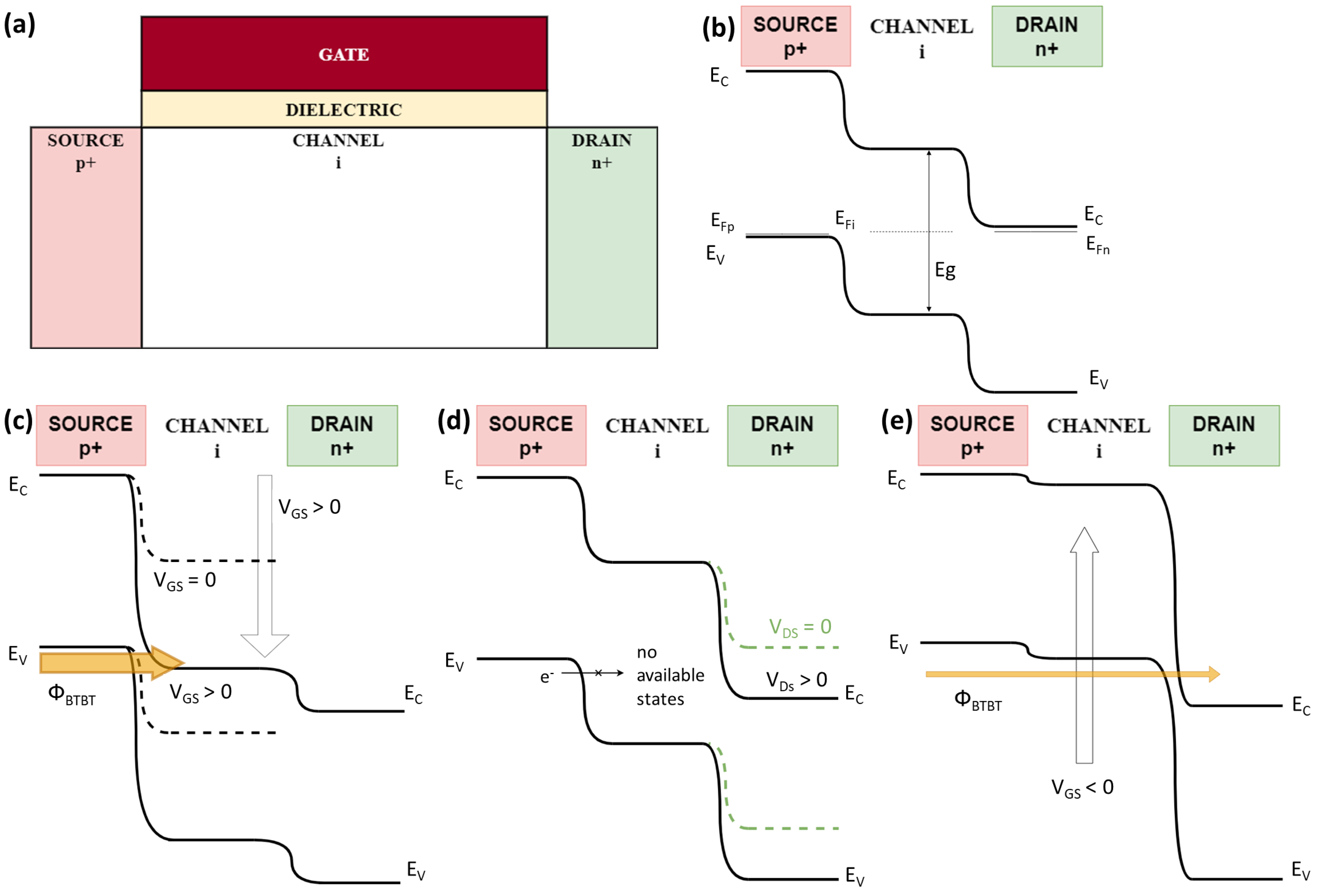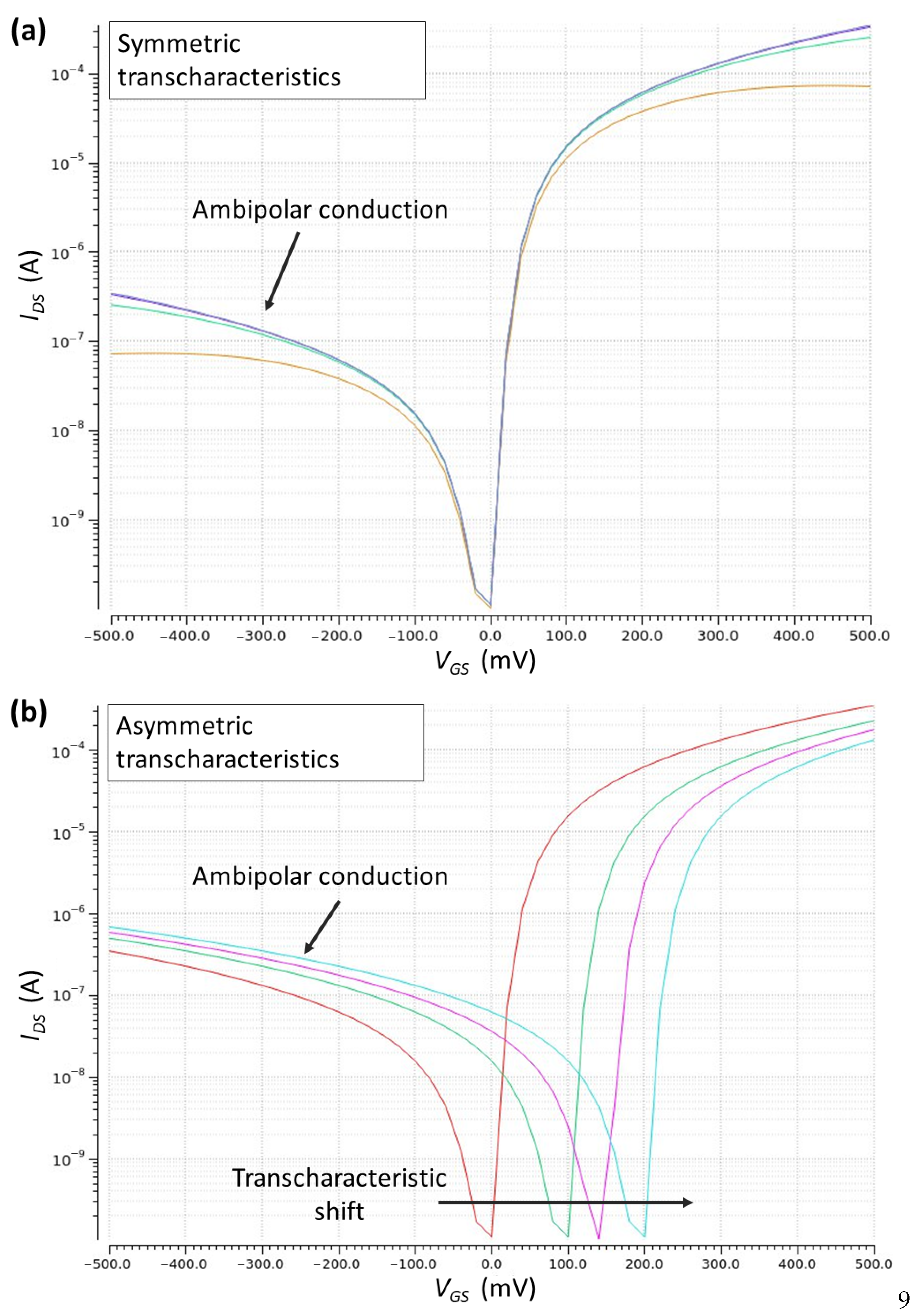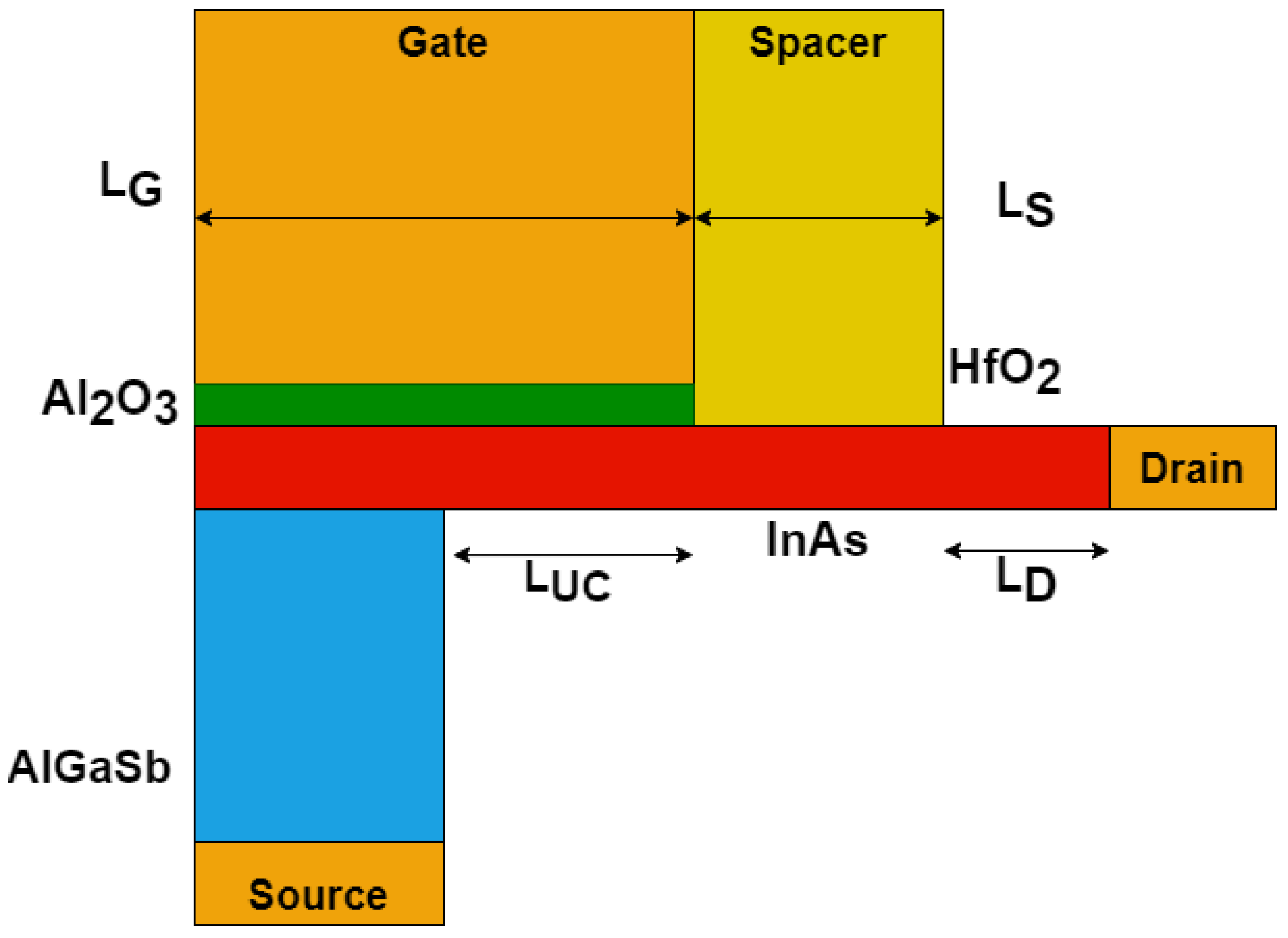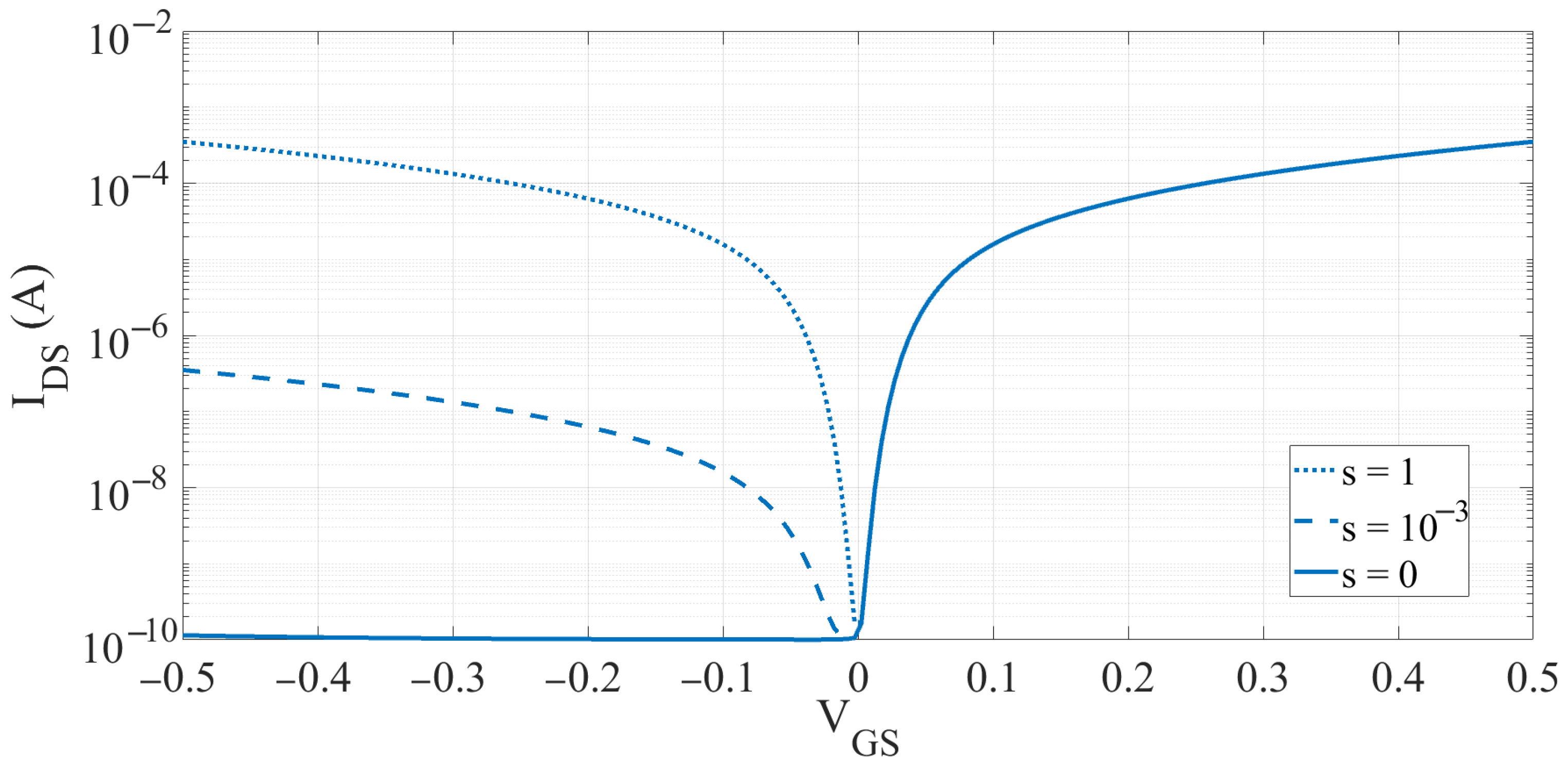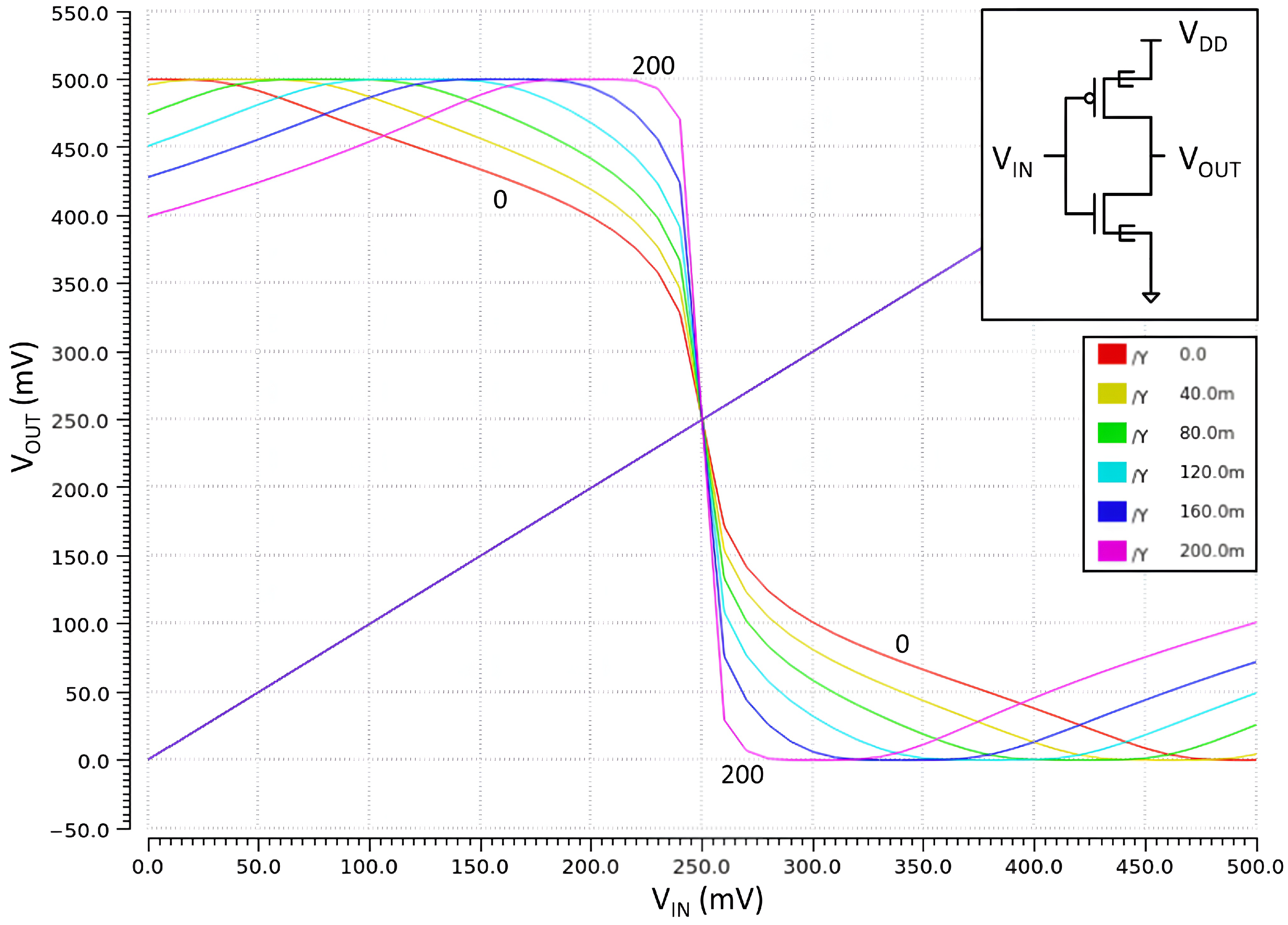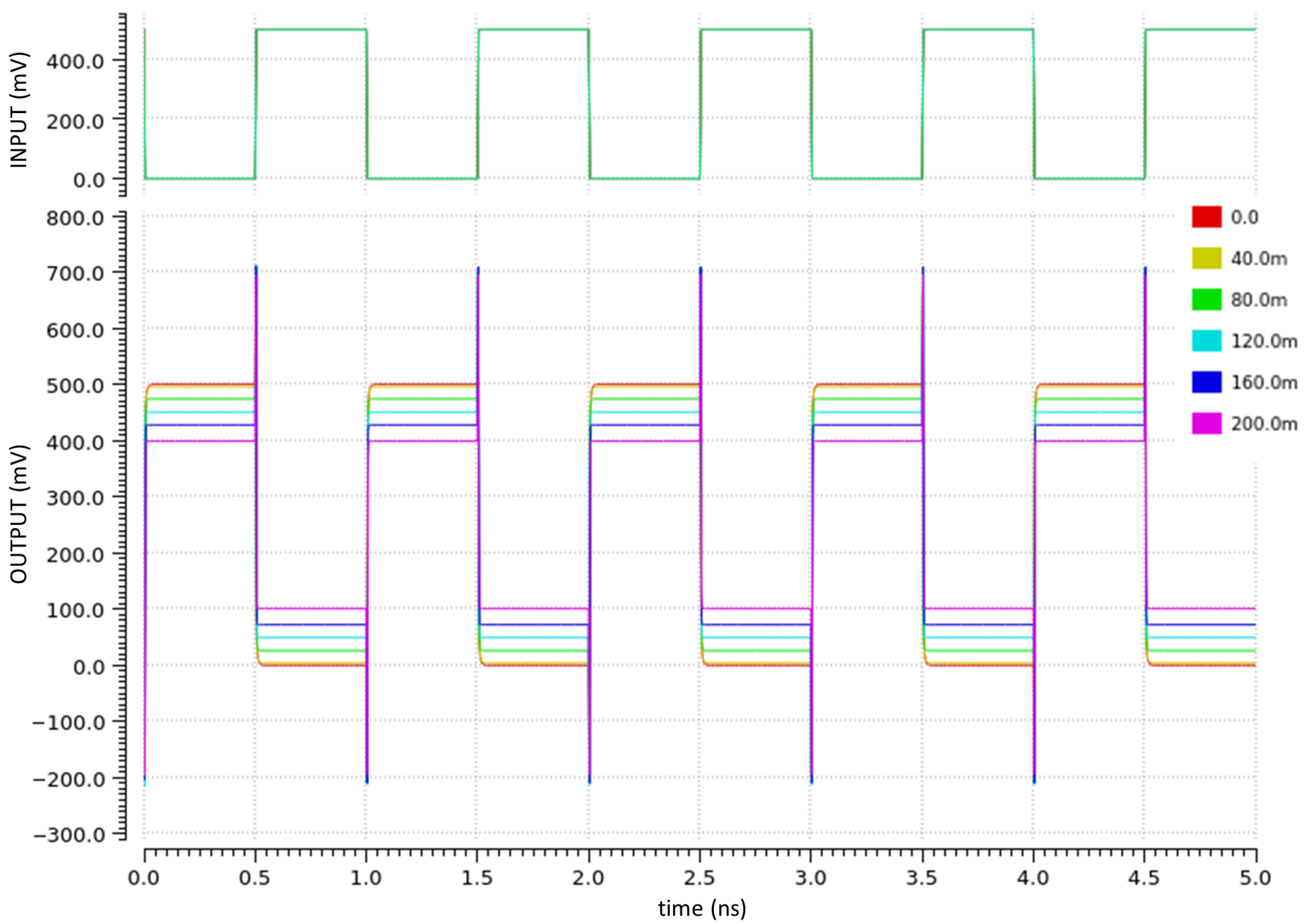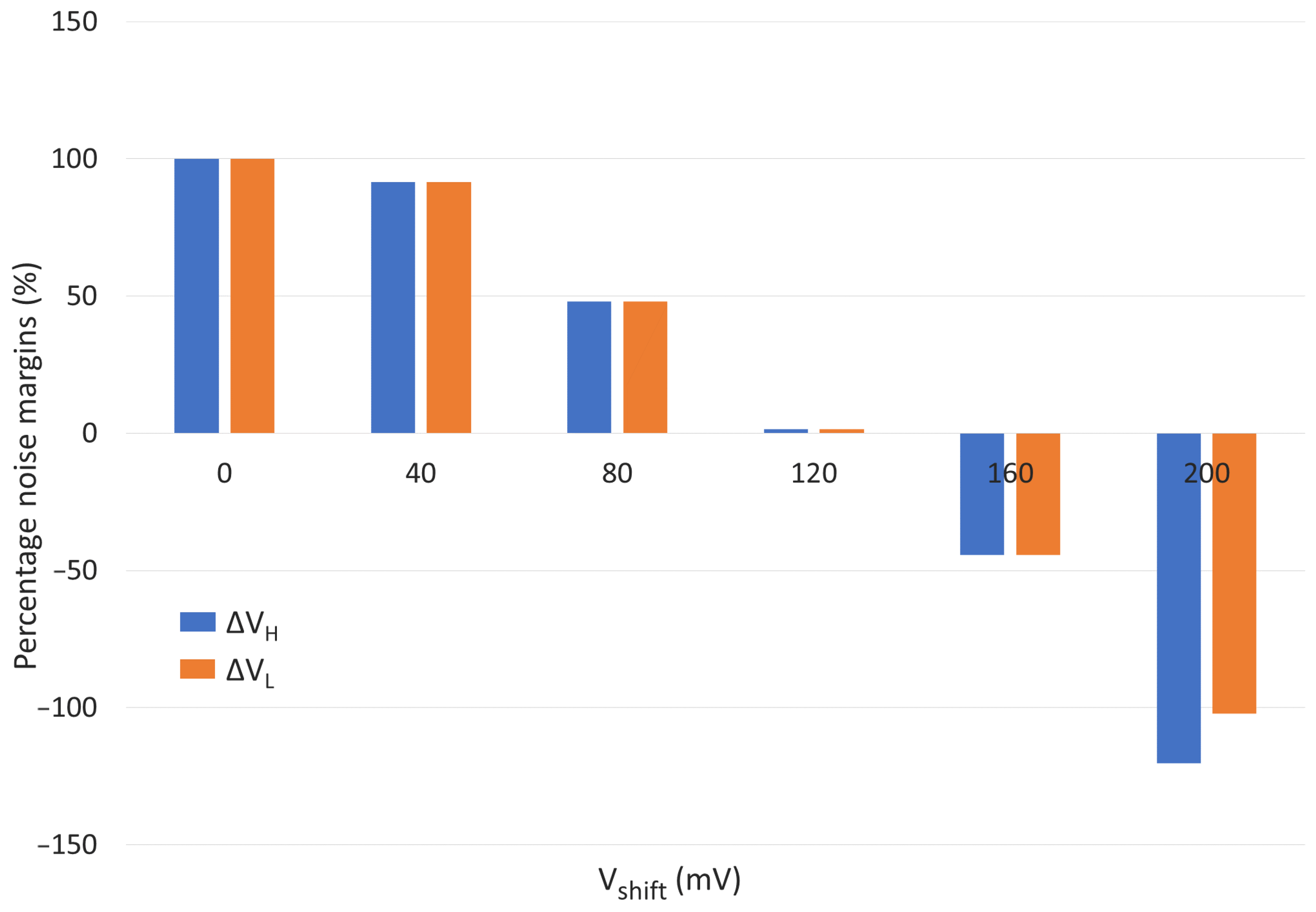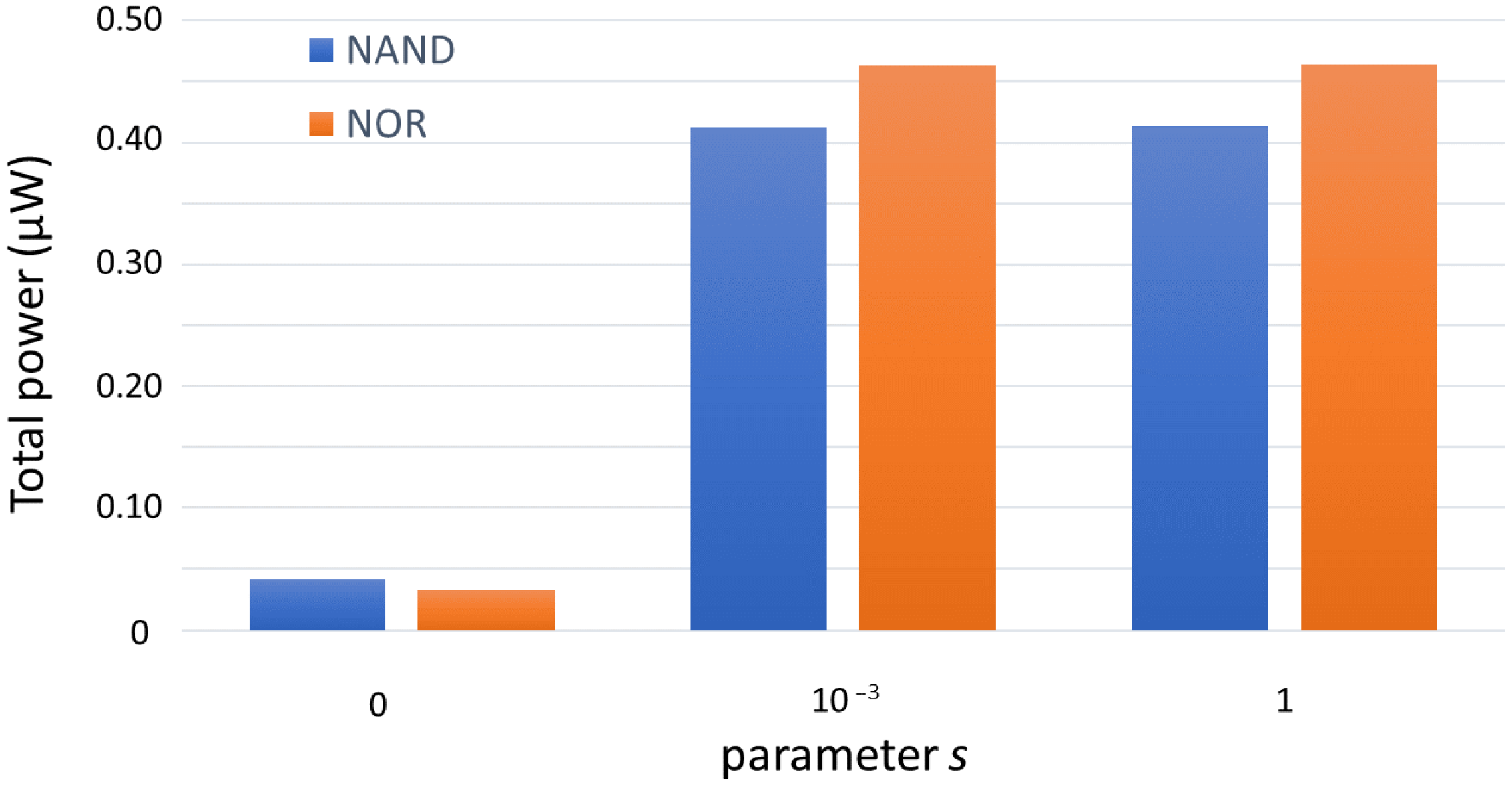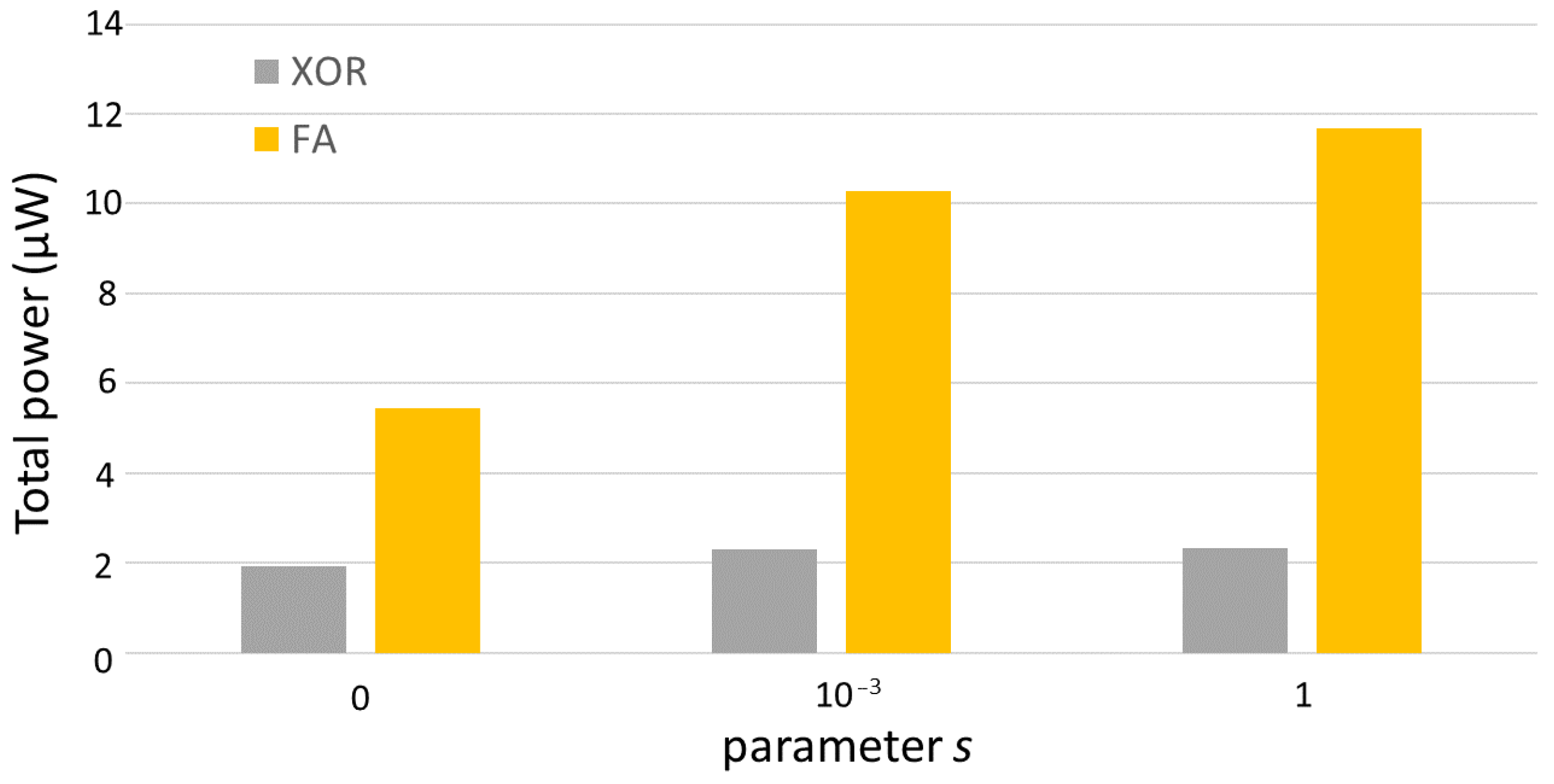Figure 5 shows the n-TFET transcharacteristic
IDS(VGS) at drain-source voltage
VDS = VDD = 0.5 V for different values of the symmetric ambipolarity parameter
s. Note the suppression of the ambipolarity current
for the transcharacteristic having
, and a substantial
comparable with the
for the transcharacteristic having
.
Table 2 reports the main figures of Merit (FoM) for the
n-type TFET device. Similar values are obtained with the
p-type TFET, thanks to the full symmetry of the device. The TFET FoMs denote a superior device performance compared with commercial 3D MOSFET such as FinFETs and NS-GAAFETs [
34,
35,
36,
37]. In particular, the obtained subthreshold slope (SS) is well beyond the 60 mV/dec room temperature MOSFET limit, with also a very competitive DIBL [
34,
35]. As expected from the literature [
4], the considered TFET also presents a poor
, and a considerably reduced
value, around one order of magnitude less than MOSFET ones [
34,
35,
36,
37].
4.1. Functional Verification
We verify the functionality of basic logic gates (NOT, XOR, NAND, NOR) and analyze what is the effect of asymmetric ambipolarity on their logic behavior. For all the logic gates, we perform DC and transient simulations by varying
, which corresponds to considering different amount of asymmetric ambipolar conduction due to physical and geometrical parameter variations and to process variations, as mentioned in
Section 2.1. In the following, we only show the most significant cases related to the digital inverter and NAND gate, where the ambipolarity strongly impact on their fault tolerances.
Figure 6 reports the Voltage Transfer Characteristic (VTC)
of the TFET-based inverter for null asymmetric ambipolarity
(red line), and finite
values (other colors). The
value is varied up to 200 mV with a fixed step of 40 mV. All the VTCs present poor performances if compared with typical CMOS ones, with very low slopes, thus requiring a large transition region in which
(or
) before (or after) the flex point at half of the dynamic voltage swing (0.25 V). Such a large transition region is primarily due to the poor driving strengths of the pull-up (
p-type TFETs) and pull-down (
n-type TFETs) networks. Indeed, because of the extremely low
value, by sweeping the
from ground to
, a sharp increment of the sub-threshold currents of the OFF networks occurs, and the typical low TFET saturation current values do not compensate such rapid increase of leakage currents.
For finite values of , the asymmetric ambipolarity gradually affects the output voltage swing of the inverter, by reducing more and more its noise margins with increasing . For low values, the gradual increase of the asymmetric ambipolarity leads to strong increment of the subthreshold current of the pull-down n-type TFET enhancing its driving strength. Because of this, the p-type TFET becomes less effective in pulling up the output line at low values of . Analogous considerations hold for high values of close to : the strong increment of the subthreshold current of the pull-up p-type TFET enhances its driving strength and the n-type TFET becomes less effective in pulling down the output line. A more ideal behavior is instead recovered for greater/lower thanks to a compensation of by itself, causing the increase/decrease before/after the transition at half of dynamic.
Figure 7 reports the transient simulation of the TFET-based digital inverter for different values of
. The evident voltage peaks in the output signals are typical of TFET technology [
28], and they are due to the asymmetric TFET structure, as mentioned in
Section 2.1. Indeed, while in CMOS technology the symmetric conduction of MOSFETs for both positive and negative
permits to discharge capacitively coupled lines, for TFETs this does not happen since a reversed
leads to poor TFET conduction and thus long time intervals to dissipate the extra charge [
28]. In the inverter case, the output voltage transients are short compared with the supposed clock period (i.e., 0.5 ns), nevertheless they are quite marked with maximum peaks that exceed
of 200 mV, i.e., 40% of the
itself (analogously for ground with −200 mV reached).
From the inspection of the output voltage dynamic evolution we notice that the effect of the asymmetric ambipolarity is to deteriorate the inverter output logic values ‘1’ (
) and ‘0’ (
).
Table 3 report the
and
values sampled at steady state and the noise margins
,
of the inverter obtained as described in
Section 3 by supposing the input characteristic in
Figure 4 not affected by asymmetric ambipolarity (
) and choosing the input logic values
450 mV and
50 mV, for which an acceptable reduction of the output logic values occurs—
Figure 6. The monotonic decrement of
and increment of
, reported in
Table 3 are the causes of the steep reduction of the noise margins for increasing
. For suppressed asymetric ambipolarity the noise margins for low and high logic values results about 50 mV, whereas for
80 mV they are almost halved. This 50% reduction potentially causes metastability and misinterpretation of the logic values when propagating throughout cascaded logic gates. The noise margins obtained for
120 mV are almost null and then negative, thus unacceptable for the propagation of the digital information, since the discrimination between the two logic values is no longer possible, and placing cascaded logic gates would cause a failure. This results is better highlighted in
Figure 8, in which the percentage noise margins are reported in function of the
values.
In the following, we also show the effect of asymmetric ambipolarity on NAND gate functioning, and we consider again different values of
. The transient simulation of the NAND gate is reported in
Figure 9, in which all the possible combinations of inputs are tested. As in the case of the CTFET inverter also the CTFET NAND gate presents output voltage spikes beyond the
and below the ground. Nevertheless, for the logic input combination
and
the output node is kept at a voltage value well beyond
for all the clock period, showing a slow exponential decay trend. A similar situation, but much less marked, is present also for the
and
case. The reasons are again related to the TFET impossible asymmetric conduction w.r.t. the sign of
, that permits extra charge discharging only through the drain to source small leakage paths [
28].
Concerning instead the effect of the asymmetric ambipolarity, in the case of
(suppressed asymmetric ambipolarity) no relevant malfunctioning of the NAND gate occurs, meaning that, analogously to the inverter case, the symmetric ambipolarity does not affect the gate functioning. This is true for all the combinations of the input. Instead, for finite
values, there is a significant noise margin reduction, with noticeable failures for large
values. Therefore, the asymmetric ambipolarity induces behavioral malfunctions in the NAND gate, making it unusable for logical and arithmetic operations. We report some output voltage values of interest in
Table 4—low logic level ‘0’ should be ground (0 V), high logic value ‘1’ should be
(500 mV). A significant reduction in noise margins already occur at
= 80 mV, with noise margins preventing cascading stages at
= 120 mV. The NAND gate does not provide correct logic behavior for
larger than 160 mV.
4.2. Power Analysis
We separately investigate the effect of symmetric and asymmetric ambipolarity on dissipated power in the basic CTFET logic cells.
Table 5 reports the total average dissipated power, calculated with Equation (
5), in function of
for the basic two-input logic gates NAND, NOR, XOR and for the Full Adder (FA). The
s parameter is fixed at
in all cases. As
increases the power consumption increases more than linearly. For example, concerning the NAND gate, by passing from
to
40 mV the power consumption is doubled, while from
40 mV to
80 mV it increases of more than seven times and from
80 mV to
160 mV it increases of four times. We attribute this trend to the exponential increasing ambipolar current values that replace the OFF current values when the transcharacteristics are shifted with increasing
-refer to Equation (
1) and the discussion in
Section 2.1.
Furthermore, we calculate the percentage sensitivity
of the dissipated power w.r.t.
starting from the definition of Equation (
4) by exploiting the approximation reported in Equation (
4). In particular, to extract the
values, we interpolate the simulated data sets of
Table 5 with straight lines (first order polynomial function) and we assume the angular coefficients of the best fitting straight line (in the least-squares sense) to be equal to
(after normalization and multiplication by 100). The interpolations are reported in
Figure 10, and the obtained sensitivity values
are reported in
Table 6. The minimum power consumption sensitivity to the asymmetric ambipolarity is obtained with the NAND gate, with a sensitivity of 17.66%. The sensitivity drammatically increases for more complex logical circuits (XOR and FA), achieving also the 182.52% for the FA case. The greater is the total power consumption of the considered logic gate (from NAND to FA) the larger is also the slope of the interpolating line, i.e., the sensitivity to
, and the circuit total power consumption dependence on
is dramatically increased if the considered digital architecture dissipates on average more power. In other words, the greater the power consumption, the greater the
sensitivity of the dissipated power from the considered digital block.
We then consider the effect of the symmetric ambipolarity on the total dissipated power. In this case, we consider only symmetric TFET transcharacteristics, i.e., we fix
, whereas we vary the magnitude of the symmetric ambipolar conduction by changing
s from 0 to
to 1. The results are reported in
Table 7. For all the considered digital cells the power consumption significantly increases when
s is increased. In particular, it dramatically increases of around one order of magnitude when
s is increased from 0 (no ambipolarity) to
(suppressed ambipolarity) for the NAND and the NOR gates. Then by further increasing
s from
(suppressed ambipolarity) to 1 (full ambipolar device) only a slight increase occurs. This trend is well highlighted in
Figure 11, where the increase in dissipated power from the case of
to the case of
is not appreciable.
Similar considerations hold for more complex digital cells, namely the XOR and the FA. Nevertheless, we notice that for more complex cells, the increase in power consumption, due to
s increase from 0 to
, is much less marked than for the simpler NAND and NOR cells, as reported in
Figure 12. Thus, we separately calculate the dissipated power sensitivity through Equation (
4) for all the considered gates for the
s increase from 0 to
and for the
s increase from
and then to 1. We call the first
and the latter
and we report the result in
Table 8. The sensitivity to ambipolar current magnitude is extremely larger for
s passing from 0 to
than for
s passing from
to 1. Even if more complex digital blocks present reduced sensitivity to
s, the trend is confirmed. Because of the direct proportionality of
to
s (see Equation (
2)) our results reflect in the following: an
three orders of magnitude lower than
values is still leading to important non-ideality power consumption and the dissipated power is very sensitive to
, thus also small reductions of
will result in large power consumption reduction.
